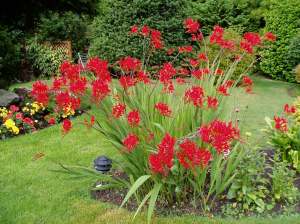If the leaf is grey & fuzzy, the deer usually turn up their noses.

Maybe they don’t like fuzz, just like I don’t like to eat the felted skin on a peach. More likely it’s because fuzz is common on drought tolerant plants. And drought tolerant plants are often dry & unpalatable. Deer aren’t stupid.

It is my good fortune that Rose Campion, aka Lychnis coronaria, is so deer resistant. They ignore the upright stems and the hot pink flowers, too.
Lychnis are tough plants. Left on their own, they’ll self seed willy-nilly. That’s not a bad thing while I’m waiting for other perennials and shrubs to mature. Because Lychnis is very easy to grow & transplant, they’ve become one of my go-to fillers (along with foxglove & snapdragons).

I grow them as a mini-hedge in hopes of keeping deer out of sections of the garden.
They’re also super-handy in areas with very little soil, or little moisture, where little else will survive 🙂
These Lychnis might not grow as tall as the ones that are irrigated, but they’re just as delightful.

Sometimes I leave the spent stems standing through autumn. The birds like the seeds.
Other times I’ll cut them back to enjoy the tidy grey mound of the plant on it’s own. That way I also get to set aside some of the seed for myself; to sow in the spring wherever I want it to grow.

Lychnis seed is very simple to collect.
- Turn the finished flower stem upside down into a paper bag.
- If the seed is ready, it’ll spill right into the bag.
- If the stems are still green, put the bag away, out of the elements, so the seed can continue to mature.
- Once it’s all really dry, while still inside the bag, shake the stems well.
- Ta-da! Seed collected.

















